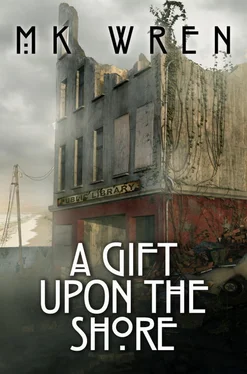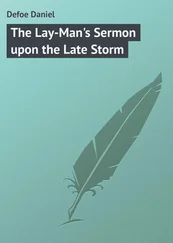Rachel and Captain Berden were waiting for her when she returned to the living room. They didn’t speak, nor did she. She was looking for something, although she didn’t understand what, not until she found it. A memento of the dream.
It was on the mantel. She wondered how she’d missed it before, how—and why—it had survived.
The old Seth Thomas clock.
It was made of quarter-sawed oak, its design stringently simple, the face set in an arch from which the sides fell straight to a curved base. The wood and glass were coated with grime. Mary opened the small door on the front panel. The hinges were stiff, but nothing inside seemed to be broken. She pushed the pendulum. It swung, ticking at a stately pace.
Aunt Jan’s great-grandmother brought this clock with her when she came west as a bride, from Portland, Maine, to Portland, Oregon, by ship around the Horn. Aunt Jan had told Mary that long ago in the summer of her childhood, when she let Mary wind the clock.
Now Mary picked it up, held it against her body, saw her tears fall onto the begrimed wood, and she knew it would have been simpler if the Rovers had killed her, too. Like Laura and her baby. That had seemed so cruelly meaningless, but death has no meaning if life is meaningless. And her tears were equally meaningless, but she couldn’t stop them. She knew the feel of these tears. Grief. She grieved again for her father, even for her mother. Grieved for Aunt Jan. Grieved for that feral-eyed girl.
Grieved for a dream.
She felt Rachel’s hand on her shoulder. “Mary, let’s go home.”
Earth knows no desolation.
She smells regeneration
In the moist breath of decay.
—GEORGE MEREDITH,
THE SPIRIT OF EARTH IN AUTUMN (1862)

Stephen latches the east gate, then, with Shadow sniffing out the way, he walks ahead of me north up the alder-shaded quarry road. It’s little more than a footpath now and wouldn’t exist at all except for our continued use of it. In dry summers we grow corn in the shielded bowl that was once a gravel quarry. Stephen stops about a hundred feet up the road, then turns east through a break in the foliage. He looks back, patiently waiting for me to catch up. Then again he leads the way, following a trail I first walked with Rachel forty years ago.
The trail winds up the valley of the Styx. The sound of water rushing over its stony, brown bed is constantly at my left, yet I seldom see the creek; it’s too densely curtained with foliage. We’ve entered a world that seems far removed—although it’s only half a mile away—from the world of the sea and the littoral. This is the forest primeval. The rain forest.
This is, Rachel told me, climax forest, the kind of forest common in the Coast Range before European immigrants razed them for houses and toilet paper. Sitka spruce and hemlock dominate here, thrusting thick boles over a hundred feet skyward. I can’t see the top of them, only the fretted pattern of twigs and needles that makes up the canopy, a pattern of exquisite complexity that’s only a blur in my old eyes.
At the feet of the giants grow thickets of thimbleberry, salmonberry, elderberry, and salal, all leggy and sparse here, not the dense growth typical of the same plants in sunnier sites. And red huckleberry. It seems to be a native son of the rain forest. Its slender trunks are brown and smooth, its branches warm green, bearing myriads of tiny, oval leaves that arrange themselves in artful clusters. I know the only art in those compositions of leaf and limb is a strategy to catch the sunlight so precious here, yet I always see a self-conscious aesthetic in red huckleberry.
At the feet of the shrubs, ferns grow extravagantly, and in miniature marshes by the creek, the gigantic, ovate leaves of skunk cabbage spring incredibly out of the mud. The ground everywhere is blazoned with the torn umbrellas of coltsfoot, miner’s lettuce starred with blossoms, oxalis like fields of shamrocks, and sweet-scented wild lily of the valley. And at every level is the moss. It furs the trunks of the trees, sleeves their branches in velvet, hangs in gossamer festoons.
The earth is rusty brown—burnt sienna, Rachel called it, verging into umber. Duff is its proper name, and if I step off the path, my feet sink into its spongy substance, and I wonder, as I always do: how many centuries of fallen needles, leaves, bark, and rotting wood, how many layers of moss, fungi, and lichen, has it taken to make the resilient texture of this ground? How many moles, worms, ants, and termites? How many billion generations of bacteria. That’s the ultimate layer of life here. I can’t see it, but I smell it in the moist, fecund air. In this context there is nothing horrific about decay. It’s the source of the richness of life here. Nurse logs. They are peculiar to the rain forest: fallen trees dissolving slowly into green mounds, supporting colonnades of young trees. Nurse logs represent an essential of life: nothing wasted, nothing lost, however profligate death might seem.
Stephen is still ahead of me, expertly wielding a machete. He wears only short, buckskin breeches on this warm day, and as he strides down the trail, slashing at encroaching salal and fern, he is as graceful and beautiful as any young creature in its true habitat.
And I, neither graceful nor young, carry no tool to keep this trail clear, but I’ve put in my share of hours tending it; Rachel and I always kept it passable. Before the End this area was part of a national forest, and the trail was built by the Job Corps. There, around the next curve, is a cement slab inscribed with the names of the six youths who were plucked from the ghettos of Brooklyn or Chicago or Los Angeles to hack a path through this temperate jungle. I wonder if any of them survived, if any lived to teach their children what they learned here.
Stephen’s machete whistles and chunks in the rich silence, while Shadow rustles through ferns, following her nose. The path angles up to its highest point, and my pace slows, my cane digs deep with every step. The light, tinted green in its passage through hemlock lace and garlands of spruce, through huckleberry spangles and veils of moss, all moving in the gentle breeze, shimmers, and it’s much like being underwater. I seem to feel the drag of it. At last, the trail slopes downward, then, finally, rounds a curve, and suddenly we are there.
It always seems sudden, the arrival here at the end and destination of the trail. Even Stephen, who has been here many times, has stopped still, staring upward.
This forest is full of giants, yet this magnificent Sitka dwarfs them all. It is two hundred feet tall, ten feet in diameter at the bole, and over five centuries old. The Forest Service provided those statistics.
But statistics don’t convey the majesty of this towering column of living wood, thick sheathed in bark as impervious as weathered granite. Its roots flare from the bole, buttressing the massive trunk, then sink into the ground in brown hills and valleys. I must tilt my head far back to see the first branches a hundred feet above me. Beyond is the crown, its immense, mossy limbs spreading masses of needles to the sun. The light is trapped there, and little escapes to warm the foothills of the roots where Stephen and I stand in silence and constant shadow.
Running entirely through the base of the tree is a tunnel at most a yard high. When I was young, I crawled through that space. The earth within was lifeless and fine as powder. I lay surrounded by stony bark, and I felt an inexplicable uneasiness, not because of the impending tons of wood above me—the collapse of that tunnel didn’t occur to me as a physical possibility—but because I sensed that I was in a place I shouldn’t be: a womb to which I shouldn’t be allowed to return.
Читать дальше













